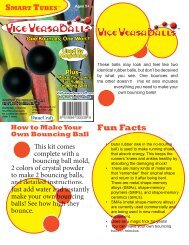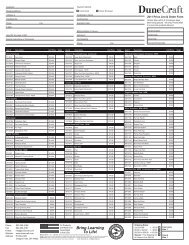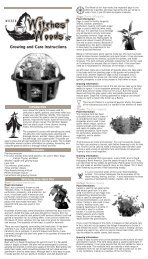Carnivorous Creations⢠- DuneCraft
Carnivorous Creations⢠- DuneCraft
Carnivorous Creations⢠- DuneCraft
You also want an ePaper? Increase the reach of your titles
YUMPU automatically turns print PDFs into web optimized ePapers that Google loves.
General Care For Seedling <strong>Carnivorous</strong> Plants<br />
Germination Period (0 to 3 Months)<br />
Most carnivorous plants are slow growers from seed and do require frequent monitoring with<br />
consistent maintenance. It is very important to keep them “just moist” during the pre and post<br />
germination period. Non-trapping cotyledon leaves (very small/short) are first produced after<br />
germination. Then, immature and not really useful working leaves with traps are formed. The<br />
seedlings are all very small and will do fine in low light level locations provided they are not kept<br />
wet. They naturally grow in dense grasses which provide a shady environment for them. At 3<br />
months, the Venus’ Fly Trap should be at least ¼” in diameter. Your Pitcher Plants 1 to 2” tall<br />
and the Sundews will be very visible.<br />
Tender Plant Stage (3 to 6 Months)<br />
The 3 to 6 month period is the crucial period for your seedlings. They will be in the process<br />
of developing a multiple root system. You can assist them by misting them weekly, with a weak<br />
solution of plant food (fertilizer). The recommended dosage is 1/10 full strength applied as a<br />
side spray mist to minimize contact with the soil medium. A common brand used by growers<br />
is Miracid, (30-10-10) or its equivalent, but any houseplant fertilizer with the right dilution will<br />
work. The amount and how long the seedlings receive light should be increased to approximate<br />
the natural mid to late summer growing conditions. You can duplicate this condition by using a<br />
basic shop type fluorescent light unit (warm or cool white lamps) placed over and within 3 to<br />
6” of the dome. A fourteen hour photoperiod (light on time) will be quite adequate and loved<br />
by your seedlings. Day and night temperatures can be increased to the 70 deg. F. night and 85-90<br />
deg. F. day range to duplicate natural habitat conditions. Humidity must be maintained at 50%<br />
plus for best results. The seedlings will show great progress during this stage of growth. The<br />
Sundews are especially fast growers and will be very impressive.<br />
Trap Development Stage (6 to 12 Months and Beyond)<br />
The seedlings have well established roots and have developed fully functional traps. They are now<br />
beyond the difficult and critical point of their growth and can take some abuse. They still need<br />
regular care. They will be able to capture bugs. A few of the taller Pitcher Plants and the Thread<br />
Leaf Sundew might be touching the top of the Dome and will need to be transplanted. Fly Traps<br />
will have ¼ inch long traps that actually will close on an insect. The uncovered Terrarium can<br />
be placed under partial shade outdoors to trap prey during humid days provided temperatures<br />
are within a comfortable range.<br />
Species Seed in Your <strong>Carnivorous</strong> Creations Kit<br />
A selection of the best species from two Genera is included in your all American carnivorous<br />
seed packages.<br />
Please be aware that except for the Sundews which usually obtain full size within 2 years, the<br />
Venus Fly Traps and Pitcher Plants may take from 3 to 5 years before they reach flowering and<br />
are near full size. Species names with some brief information on each are provided for your<br />
edification.<br />
• Venus Fly Trap (Dionaea muscipula): A native of N & S Carolina. Trap size up to 1-1/2” on older<br />
plants. Produces a cluster of white flowers in May/June<br />
• Pink Sundew (Drosera capillaris): Very common in coastal bogs from Texas to Virginia. Rosette<br />
to 1-1/2” diameter. Fast grower with pink flowers<br />
• Dewthreads Sundew (Drosera filiformis-tracyi): Common in bogs between Mississippi and<br />
Florida. A very fast growing and tall (18”) plant that is especially good at catching gnats and other<br />
small bugs. Lavender Flowers and abundant seed in the spring<br />
• Oblong-leaved Sundew (Drosera intermedia): Coastal bogs from Texas to Maine and Great<br />
Lakes region. Semi-erect plant to 8” in wet conditions within 2 years. Small white flowers<br />
produced in late summer<br />
• Pale Pitcher Plant (Sarracenia alata): Found in isolated pine forests between Texas and Alabama.<br />
30 to 36” tall when fully grown. Pretty Pale yellow flowers in early spring<br />
• Yellow Trumpet Pitcher Plant (Sarracenia flava). Once common in Alabama to S. Virginia in<br />
savanna bogs. To 42” tall in shade, but usually 30” in sunny areas. One of the fastest growing<br />
Pitcher Plants from seed. Smelly Yellow flowers in early spring<br />
• White-Topped Pitcher Plant (Sarracenia leucophylla). Possibly the most spectacular pitcher plant<br />
with its majestic and large pitchers. Greatly decreasing in numbers due to habitat destruction in<br />
Gulf Coast bogs between Mississippi and the Florida Panhandle. Often 36” tall. Produces spring<br />
and then a late summer flush of pitchers. Red flowers on a tall scape in early spring<br />
• Hooded Pitcher Plant (Sarracenia minor). Unique looking 12” tall pitchers in late spring. Pretty<br />
yellow flowers in late spring. Native to coastal and inland pine forests between Central Florida<br />
and Lower N. Carolina.<br />
• Parrot Pitcher Plant (Sarracenia psittacina). Small rosetted plant typically less than 8” in diameter,<br />
larger in very wet habitats that maintains pitchers throughout the year. Coastal Louisiana to<br />
inland Georgia pine/seep bogs. Dark red flowers in late spring<br />
• Purple Pitcher Plant (Sarracenia purpurea-venosa). We offer which is considered the southern<br />
form of this species which is found from Delaware south to Mississippi. It does not have a lid,<br />
but captures water to drown insects. Typically up to 10” in diameter. One of two pitchers that<br />
keeps its pitchers year round. Red to pink spring flowers<br />
• Sweet Pitcher Plant (Sarracenia rubra-wherryi). One of the varieties in the rubra complex.<br />
This form is native to eastern Mississippi and lower Alabama. Pitchers vary in size from 10 to<br />
16”. Red flowers in late spring<br />
Plant Growth Factor Comparison<br />
Basic Growing Rules to Follow<br />
• If you do not plan to use the seeds for a while, store them in the refrigerator, as<br />
opposed to a freezer.<br />
• Carnivores live in high rainfall areas and like pure water. You won’t need much; a<br />
gallon will last a long time. Obtain purified, distilled, or use collected rain water if<br />
you are unsure if your tap water is pure enough.<br />
• The top few inches of sandy based peat soils in natural habitats dry out quickly.<br />
Water is frequently held well below the surface level. That’s why we don’t keep the<br />
plants totally wet or waterlogged. Young carnivorous plants like to be kept just<br />
slightly moist. Once the plants are over 6 months old, you can slightly increase the<br />
saturation level of the growing medium.<br />
• Your plants will flourish in the provided terrarium, with or without food. If you do<br />
not feed them captured insects, continue with diluted fertilizers. Never feed raw<br />
meat to plants. Eventual bacterial growth will decay the trapping leaf.<br />
• While your <strong>Carnivorous</strong> Plants will thrive in bright indirect light, they will wilt in<br />
the heat of direct sunlight.<br />
• Periodic removal of the dome to air out the plants and to help prevent fungus<br />
growth can be done every few weeks in locations with reasonable humidity levels.<br />
• The plants like to be kept cooler in the winter, 60 degrees, and warmer 75-85<br />
degrees, in the summer.<br />
• The biggest danger to your seedlings will be gray mold. It will look like a damp,<br />
gray fluff and typically strikes in cooler conditions. You can remove the mold by<br />
spraying the soil with a 1:50 mixture of hydrogen peroxide and water. If mold starts<br />
to appear, reduce the moisture and water the plants with a mixture of one capful<br />
of hydrogen peroxide to seven ounces of water. This will kill the mold but not the<br />
plant.<br />
• If you decide to transplant your carnivorous plants, it is important to use the<br />
correct soil. A simple to provide equal mixture of milled sphagnum peat moss with<br />
washed sand (construction, horticultural, or play sand) works well. Never use beach<br />
sand as the salt content will render the medium harmful to your plants.<br />
• Insect pests such as aphids and mealy bugs do attack mature pitchers. Diluted<br />
soap or oil sprays can safely be used.<br />
The following 3 Photographs are for you to use to gauge the size of your<br />
plants to average growth under good conditions. The top row consists<br />
of S. purpurea-venosa, D. filiformis-tracyi and S. leucophylla. There are 2<br />
Venus Fly Traps in each photo. All sizes are approximations for the stated<br />
ages and will vary considerably with individual plants based on the time of<br />
year and conditions under which they are maintained.<br />
Over-wintering Your Mature <strong>Carnivorous</strong> Plants<br />
The seeds in your kit are perennials that can live for many years with the proper care. A few of<br />
the Sundews in your terrarium will naturally lose all of their leaves and form a protective winter<br />
bud that will reopen in the spring. Most of the other species will need a resting or dormancy<br />
period after their second growing season. Growth will stop as days become shorter and colder.<br />
Old pitchers will wither and brown and Venus’ Fly Traps will become much smaller and sluggish.<br />
Remove all dead leaves and reduce how often you water them. Simply remove the greenhouse<br />
top, cut off all dead foliage, cover and place in a refrigerator for two months. You can also place<br />
them outdoors or in an unheated garage for two months if you live in an area with a cold, but<br />
not extreme winter. The plants cannot be allowed to freeze.<br />
• It’s okay to let your pitcher plants dry out more during this dormancy period. Periodically just<br />
add enough water to keep the medium moist.<br />
• After two months, water the plants, replace the lid, and place in a window with a southern or<br />
eastern exposure. New growth should resume shortly thereafter.<br />
Customer Service:<br />
Visit our web site: www.carnivorouscreations.com for more information<br />
about this product.<br />
Email sales@dunecraft.com, or call 1-800-306-4168 with questions.<br />
Visit our web site www.dunecraft.com to:<br />
• Locate retailers near you!<br />
• Learn more about your product!<br />
• Learn more about our other products!<br />
©2007 <strong>DuneCraft</strong>, Inc.<br />
All Rights Reserved<br />
PO Box 808<br />
Chagrin Falls, OH 44022














